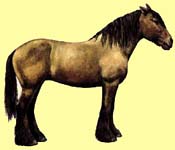|
|
The Poitevin |
|
|
|
The Poitevin |
|
 The Poitevin descends from horses of various extractions imported from the Netherlands, Norway, and Denmark by the Dutch. The Dutch used the Poitevin in land reclamation work in the region around Poitiers.
The Poitevin descends from horses of various extractions imported from the Netherlands, Norway, and Denmark by the Dutch. The Dutch used the Poitevin in land reclamation work in the region around Poitiers.
When crossed with local mares, these horses produced the Poitevin breed, which is also known as the "Mulassier." "Mulassier" means "mule breeder, and refers to this breed's used in the production of mules. In danger of extinction in the 1950s, the Poitevin is currently enjoying a revival, with a lot of thanks to a considerable demand from other countries. The genealogical register for these brachymorphic horses dates back to 1884.
This horse stands 15 to 17 hands high and weighs 1,540 to 1,980 pounds. Its coat color is usually bay, grey, black or palomino. The heavy head has a straight or slightly convex profile, and a full forelock. The ears are large and thick and the eyes are small and not very expressive. It has a short, broad and muscular neck with a thick mane, and the withers are also broad, muscular, and slightly pronounced. The straight back is broad and long, and the loins are broad. Its croup is fairly long and sloping, and its tails is full and flowing. It has a deep chest, and a quite well-developed abdomen. the shoulder is sloping but not well-formed. The rather thick and short legs have broad joints, long cannons, broad feet and some feather.
The Poitevin's temperament is lethargic and well-balanced, but it is not very lively. Being string and with good endurance, is has an aptitude for heavy draft and farm work.
For more information, visit:

|
© 1997-2007
NW Breyer Horse Club & Refiner of Gold Creations Equinealities in place since 1997, Section in place 2001, Updated 3/13/2007 |



|
| ||

|
|||||